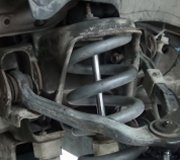Hi sicluvsong. Welcome to the forum. The ABS axle is irrelevant. On most cars, the axle shaft is the same. They just add a toothed tone ring for cars with ABS. Often all replacement shafts for a specific model are rebuilt with that ring so they only have to stock one part number. It will work in cars with or without ABS.
As a side note, GM front-wheel-drive cars have the ABS sensors built into the wheel bearing assemblies. That means fewer people and less time needed to assemble the car, but it means WAY higher repair costs for owners. The funny thing is, a new bearing assembly without the sensor costs twice as much as the same one with the sensor. They are otherwise identical. We always buy and install bearings with the ABS sensor for cars without ABS, then just don't connect it to anything. The sensor can be pounded off too, but why bother?
The axle seals in the transmission getting torn during the first service is very common and often doesn't show up right away. It can take up to a few days for fluid to work its way out far enough to start dripping on the ground.
On Chrysler products, it is extremely easy and cost-effective to just replace the torn cv joint boots. Older GM products aren't too bad either, but on most imports, the boots tend to last longer, need fewer replacements, but when they do, disassembling the shaft can be quite an ordeal. While the boots are available, professionally rebuilt half shafts have come down so much in price the last ten years, it is more cost effective to just pop a new shaft in rather than spending four or five hours at $100.00 per hour to try to replace the boots. You usually benefit dollar-wise when your mechanic replaces the entire half-shaft.
As for the rattle, the most common cause right after other service work, is a loose metal shield that didn't get tightened, or is slightly off-center and hitting a suspension part. Most of the time this isn't serious, just irritating, but the lower ball joints had to be separated to replace the half shafts. If one of them didn't get tightened properly, it could separate while driving, leading to loss of steering control and a crash. On most cars, the wheels are designed to prevent the joints from separating completely but that is something that will have to be checked during an inspection. Older Mazdas had an uncommon way of bolting the stud of the ball joint in place, and it is possible for the nut to appear to be tight, then the stud fully seats itself during driving over bumpy roads and the nut becomes loose. The joint can't totally separate until that nut vibrates all the way off which usually won't happen because it is too tight. Besides the rattle, tire wear and unsteady handling will result.
The original mechanic should be given the chance to correct the cause of the rattle if he caused it. You can be irritated at having to bring the car back again, but outward signs of frustration and anger won't help. The mechanic and shop owner already know someone had a bad day. When I had customers who were not visibly angry, I went out of my way to try to remedy any problems I caused as quickly as possible. People who were angry got the same service; it just ruined my day.
One tool that can be used for rattles is called the "Chassis Ear". It is a set of six microphones that are clipped onto suspect points, a switch box, and a pair of headphones. You switched between the microphones and listened while driving the car. Most new car dealerships have one of these tools, but many mechanics have never heard of it or seen one. That is a last resort though. Usually a thorough inspection of the suspension and steering systems, and a few taps with a rubber hammer will identify the cause of the rattle. There are a lot of things that can be overlooked, and it gets worse when two people work on a car. Each one can think the other one tightened a bolt or repositioned a shield that had to be moved out of the way.
Caradiodoc
Friday, September 10th, 2010 AT 2:22 AM


